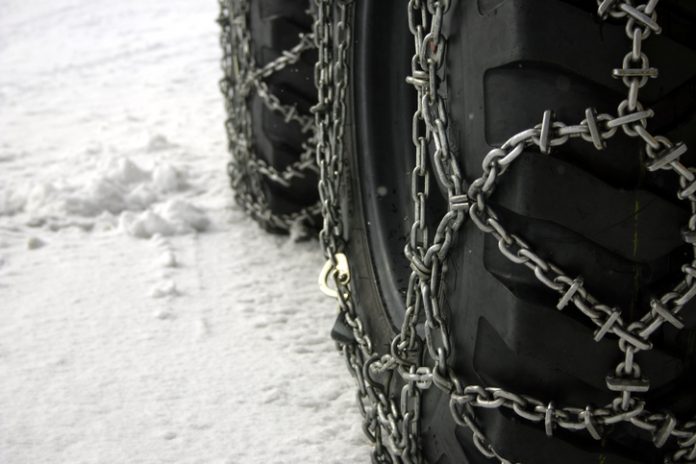It’s getting to “that time of the year” again, where we will soon be needing to carry and possible use tire chains. I know, I know… Nobody really enjoys winter driving, but it’s just something we have to deal with. East of British Columbia, they are not needed, and in most of Canada their use is not permitted, but if you run British Columbia, they are a definite must. In addition to British Columbia, the states of Washington, Oregon, Idaho, Colorado and California all require you to carry a minimum amount of chains, or similar traction device. A quick on-line search for pertinent chain up requirements shows that the laws can vary greatly between different provinces and states. Even Texas, Tennessee and South Carolina allow for tire chains when conditions warrant. For our purposes, I’ll stick mostly with British Columbia’s chain laws, as they are the most stringent.
My best personal advise regarding chaining up is… Don’t. In my opinion, if the roads are that bad, you probably shouldn’t be on them in the first place. Check the prevailing weather and road conditions before heading into an area that might require chains. If the chain laws are in effect, or the weather looks like the chain laws may be put in place, stay parked. It’s easier and less expensive to reschedule a pick up or deliver appointment than it is to recover a load that’s in the ditch.
Before I get started, let’s first have a look at the different traction devices available:
Snow Socks: These are soft, fabric tire covers that resemble, well, socks, that go over the tires. On the plus side, they’re lightweight, easy to handle, and fold flat for storage when not in use. On the negative side, while they may work well on your personal vehicle, they do little to no good on a commercial vehicle. Snow socks are not recognized as proper traction devices on vehicles over 11,794 kgs in British Columbia, and their use will get you put out of service, resulting in a huge towing bill and you will be parked, possibly for 3 days or more, until the chain up laws are removed. You will also be fined for not carrying the minimum number of required tire chains
Steel Cables: Steel cables are similar to tire chains, in that they attach to the tire, and are therefore less likely to slip. They are much lighter than tire chains, but can be difficult to store when not in use due to the rigid design. Like snow socks, they are not recognized as proper traction devices on vehicles over 11,794 kgs. in British Columbia, and their use will carry the same financial and time penalties.
Steel Tire Chains: These are the only traction devices allowed in British Columbia for vehicles over 11,794 kgs. You are required by law to carry a minimum number of tire chains between October 1 and May 1, regardless of the weather. For a truck and a single trailer, you must carry at minimum, enough chains to equip 4 drive tires: Either 4 single chains, or 2 triple chains. I prefer 4 singles, as they are far easier to install. One chain on each of the outside drive tires. If you use triples, they should be installed on the front drive axle.
What is a triple tire chain? A triple tire chain (called “triples”) cover both tires on the drive axle and they have 3 connection points: One on the outside of the outer tire, one on the inside of the inner tire, and one in between the tires. This can make them extremely hard to work with. If you’ve never installed tire chains before, I strongly suggest you have an experienced driver show you how to install them. There are also tutorial videos on YouTube to help you learn how to install them. Don’t do like I did! I had a vague idea how to install them, then just before Christmas last year, I found myself at the chain up area just before Kootani Pass on BC-3 trying to install chains for the first time. It took me 3 hours to install 2 triples, and by the time I was done, I was cold, wet and absolutely filthy! It wasn’t a great experience, but it taught me a LOT about what I needed to carry in the future!
This is a rather long video at 42 minutes, but it will save you a LOT of time if and when you have to install tire chains for the first time. I’d also recommend (silly as it might look) that you actually install them on a nice, warm sunny summer day, so that when winter hits, and you need to put them on, you have a much better understanding of what you are actually doing,
The best time to install the chains is before you need them. Check the weather conditions for the highways you will be travelling. British Columbia has many on-line resources regarding road and weather conditions, as well as “chain requirement” page, which can be found at “www.drivebc.ca/chainup.php”. Try to avoid waiting until you get to the last chain up area. If you know the chain laws are in effect, find a designated chain up area before the weather and road conditions get bad, and install your chains there. It will save you time, and you won’t be outside working in some nasty weather. If you do find yourself caught in the slush, ice and snow and you have to install your chains, be sure you dress properly for working outside. It should go without saying, but I’ll say it anyway: Long underwear is a must! Good winter gloves that will help keep your hands warm are another must. When I’m going to be working outside in the winter, I always have 3 or 4 pairs of good fur lined winter gloves on hand, and a steady supply of latex surgical gloves as well. The work gloves aren’t water proof, and the salt water from the road and slush will have your hands wet and cold in no time. The surgical gloves will help keep your hands dry, and therefore, help keep them warm as well. I also carry a warm winter overalls, complete with the safety stripes, which not only keeps you warm, and relatively clean, but makes you visible if you happen to find yourself working on the shoulder of the road at night.
When using tire chains, always engage the power divider, or differential locks to help reduce the risk of spinning out. If you spin out with tire chains installed, you will pretty much come to a dead stop, and there is a very high probability of damaging your chains, fenders, mudflap holders and brake components.
When you finish with your tire chains, be sure to store them properly. If your truck has chain hangers, use them, and make sure they don’t drag along the road surface as you drive. Nothing destroys tore chains like having them drag along the road surface as you drive.





















